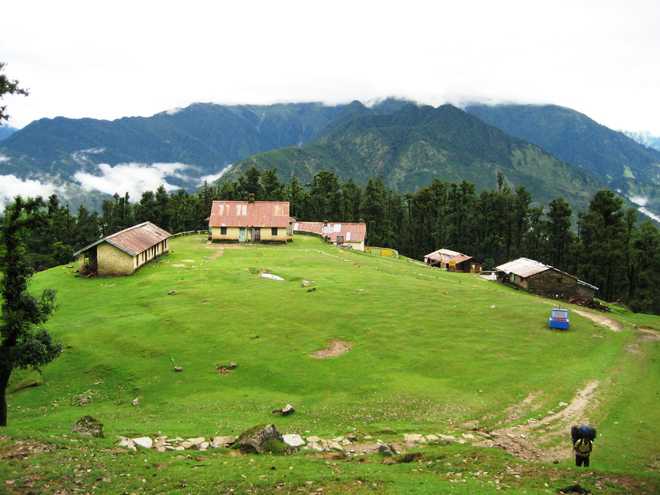BD Kasniyal
Pithoragarh, May 15
Tourism in the Kumaon region, which started thriving with the arrival of the British, has come of age. There are numerous spots here which catch tourists’ fancy. The government is yet to develop several places that have the potential to become good tourist spots.
After tourism emerged as a source of livelihood in the state, the government started exploring new tourist spots to lessen burden on traditional tourist places such as Nainital and Mussoorie. Besides, the new tourist spots will provide more jobs to local youths.
Tourists coming to Nainital to beat the heat can be encouraged to visit lesser known places such as Pangot situated 15 km from Nainital. The area houses over 150 varieties of birds and hence is a boon for birdwatchers. Besides, Ramgarh, Mukteswar, Sat Tal, Bhimtal and Paharpani are other places of interest where tourists can enjoy watching birds, Himalayan peaks and take a close look at the dense flora and fauna. “Mukteswar, 52 km from Nainital, can be included in the tourist itinerary for its developed design, sprawling bungalows and forest cover,” says Jagdish Joshi, a Nainital-based journalist.
Almora district, the cultural centre of the Kumaon region, is famous for its temples and sunset view. Well-known personalities such as Swami Vivekananda, Mahatma Gandhi, Ravindranath Tagore and Jawaharlal Nehru have visited Almora. “Besides traditional tourist attractions in Almora, we have the Binsar bird sanctuary adjoining the town and the Surya Temple at Katarmal, which is over 1,000 years’ old. Some places of archaeological interest are neglected. The Tourism Department should take care of these places,” says Navin Bist, a journalist in Almora.
Champawat district, which was home to Chand kings until Gurkhas’ invasion in the late 18th century, has no traditional place of mainstream tourism. It has several attractive places such as the 7th century Baleswar Temple, Mayawati Ashram (that Swami Vivekananda visited), Ek Hathiya Ka Naula and a water well constructed by a craftsman who had built the Baleswar Temple. The then king of Champawat got the hands of thecraftsman amputated as he didn’t want him to construct another structure of such beauty.
“Ek Hathiya Ka Naula and the Gorakhnath Temple, 30 km from Champawat, should be developed as tourist places,” says Dinesh Pandey, a local resident. The bungalow of Jim Corbett in Manch village and Abbott Mount in Lohaghat town should also be developed as tourist spots.
Residents of Munsiyari, a tourist place in Pithoragarh district, say they have not been given sufficient representation in the tourist itinerary in the Kumaon region as some of the leading trekking spots in the town have not been developed. “Martolithod, Chulkot, Rud Khan and Lal Singh Gair, besides Khyulia Top are good for trekking and, if developed, can attract tourists from across the country,” says Puran Pandey, a tourism trader and resident of Munsiyari.
The Tourism Department has ignored several places of interest in Bageshwar and Pithoragarh for years. Pundusthan, around 30 km from Bageshwar town, gives a serene look. “Chandak near Pithoragarh town, ancient Malayanath Temple and Jal Devi near Didihat should be developed to draw tourists in the eastern part of the Kumaon region,” says Sanju Pant, a resident of Didihat.
Bageshwar has several places of tourist attraction. The most famous of these is the Pindari glacier. It is 3 km long and situated at a height of 3,353 metre and 83 km from Bageshwar town. Besides the Pindari glacier, the Sundardhunga and Kafni glaciers situated in the same region are also important tourist attractions. “Besides these glaciers, the trail pass that connects Munsiyari to the Pindari glacier, revived by GW Trail in 1830, is also a tourist attraction in the district. Trekkers use the trail pass to reach Munsiyari from the Pindari glacier by skiing,” says Joshi.
The route to the world famous glaciers of Pindari, Sundardhunga and Kafni in Bageshwar district attract trekkers and solace seekers from across the world. British writer and traveller Col Garden (retd) has said the glaciers of the western Himalayas are twice as extensive as those in the Alps and are probably the largest in the world. The British discovered the Pindari, Sundardhuga and Kafni glaciers in 1913. “The sprawling Pindari glacier is well known by the proverb that it melts in daytime and freezes in the night. The glacier is the mouth of the Pinder river, which turns towards Garhwal some distance down,” says Keshav Bhatt, an ace trekker and journalist.
Unlock Exclusive Insights with The Tribune Premium
Take your experience further with Premium access.
Thought-provoking Opinions, Expert Analysis, In-depth Insights and other Member Only Benefits
Already a Member? Sign In Now










